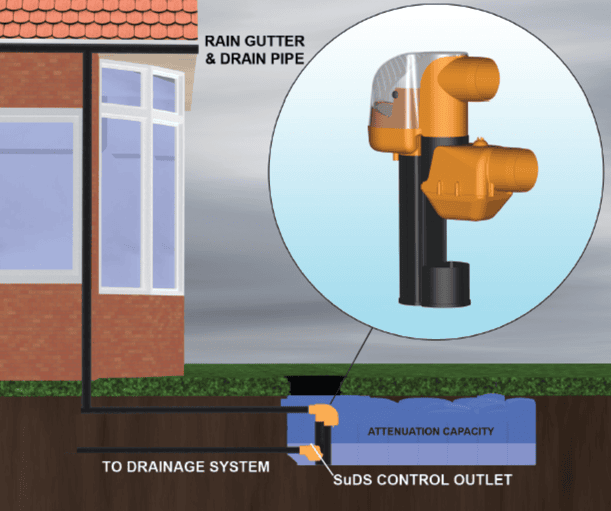Ultra-low discharge storm attenuation device

Problem Addressed
This solution was sourced in response to UKGBC’s Innovation Challenge: “How can existing buildings be made more resilient to climate change, with as little disruption to their occupants as possible, by 2030?”
The UK is starting to experience ‘Mediterranean’ storm events where the downpour is heavy for a shorter period of time. This type of storm event is exerting extreme pressure on the UK’s existing drainage system. With increased development, vast swaths of land are becoming impermeable, and due to recent localised flooding incidents, planners are putting a high emphasis on new developments to include an effective future proof drainage strategy.
Verification & Case Study
All designs using the Rain Activ are established using Micro Drainage calculations. The capacity required in each tank is determined by the results of the calculations based on the storm event which is used and the discharge rate required. Normally this is 1:100 year storm event.
Case study
Site: The RainACTIV system was installed in a family home in Truro, Cornwall. Rainfall from a roof area of 110m² is routed into a 5000L shallow dig harvesting tank. Around 3000L of the tank’s capacity is used for rainwater harvesting, with the remaining 2000L used to attenuate flows at a controlled rate during intense storm events.
Objectives: Reduce storm water discharge rates to new industry lows of 0.3l/s whilst simultaneously providing full domestic rainwater harvesting for the family’s toilets, washing machine and garden tap. Monitor the tank level data to provide an accurate representation of domestic rainwater harvesting consumption as well as stormwater discharge rate.
Specification: The rainwater harvesting capacity was calculated to BS8515, 3000L of storage was specified-providing enough volume for around 600 free toilet flushes! A WRAS approved management system was installed to provide backup during dry periods. Stormwater is discharged though a 10mm orifice to control the flowrate into the drainage network. 2000L of capacity is available for attenuation. During the critical 1:100 year storm event with a 40% climate change allowance, the inflow is predicted to be 3.1l/s with under 0.3 l/s discharged.
Results: The team have been amazed at the extent rainwater harvesting has reduced the strain on the drainage network. In 12 months, the system discharged just 4 times into the drainage network. Even when it did discharge during the heaviest storm events, the rate was controlled at under 0.3l/s This clearly shows the tremendous effect of rainwater harvesting as a method of attenuation.
Facts and Figures



This page presents data, evidence, and solutions that are provided by our partners and members and should therefore not be attributed to UKGBC. While we showcase these solutions for inspiration, to build consensus, and create momentum for climate action, UKGBC does not offer commercial endorsement of individual solutions. If you would like to quote something from this page, or more information, please contact our Communications team at media@ukgbc.org.
Related
Tool for mapping natural capital assets and ecosystem services

Vacuum drainage toilets

Smart Blue-Green Roof

IoT remote monitoring solution

